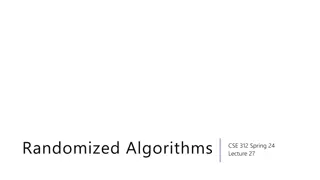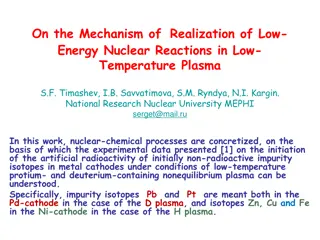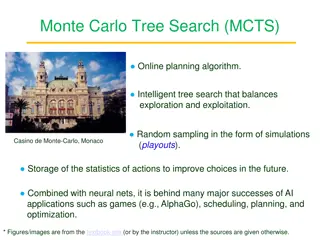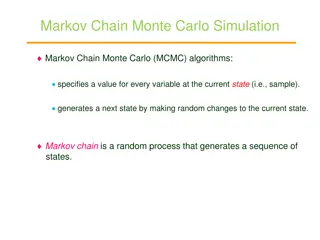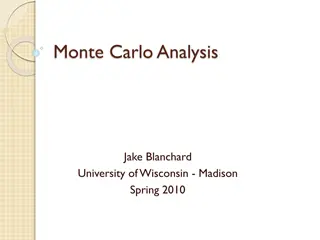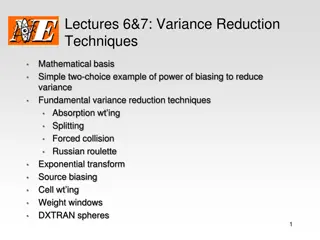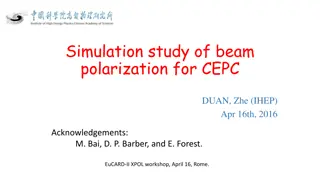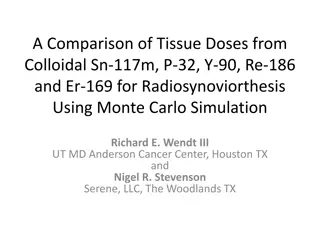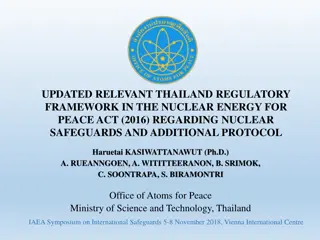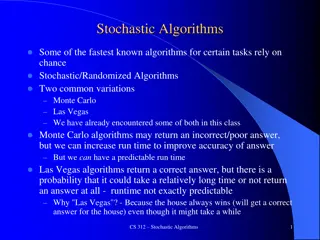Unified Monte Carlo: Nuclear System Analysis
In the field of nuclear system analyses, the concept of Unified Monte Carlo involves constructing a multi-variate master probability function using theory and experiment data. This function is then sampled to generate random observable parameter vectors for practical applications such as evaluations and system parameter analysis. Bayes Theorem plays a significant role in relating prior theoretical knowledge with independent experimental data to form the posterior probability function. Topology issues in mapping theoretical algorithms to observable spaces are also addressed, ensuring non-negligible probability regions are considered. The process involves complex algorithms and Monte Carlo techniques to generate Markov chains for both theoretical model parameters and calculated observables.
Download Presentation

Please find below an Image/Link to download the presentation.
The content on the website is provided AS IS for your information and personal use only. It may not be sold, licensed, or shared on other websites without obtaining consent from the author.If you encounter any issues during the download, it is possible that the publisher has removed the file from their server.
You are allowed to download the files provided on this website for personal or commercial use, subject to the condition that they are used lawfully. All files are the property of their respective owners.
The content on the website is provided AS IS for your information and personal use only. It may not be sold, licensed, or shared on other websites without obtaining consent from the author.
E N D
Presentation Transcript
UMC: Unfinished Business Donald L. Smith (ANL, retired) Roberto Capote (IAEA) Denise Neudecker (LANL) CSEWG Meeting 2 4 November 2015 ?
UMC Unified Monte Carlo The Concept Assume that knowledge about a set of nuclear observable parameters employed in nuclear system analyses can be represented by a multi-variate master probability function. This function should be constructed by incorporating the best available information from theory and experiments. The master function is then sampled using Monte Carlo methods to generate a Markov Chain of random observable parameter vectors that ultimately can be employed for a variety of practical applications such as generating evaluations and analyzing the behavior of derived nuclear system parameters.
Master Probability Density Function Bayes Theorem: p(x|T T,E E) = p0(x|T T) L(x|T T,E E) T T signifies prior information based on theory (modeling). E E denotes independent information from experiments that serves to improve (or augment) prior theoretical knowledge T T. x represents random vectors corresponding to possible values of the nuclear observables (e.g., cross sections). The prior probability function p0is based on theory, while likelihoodL is a probability function that quantifies the consistency of data from theory and experiments used to construct the master (posterior) probability function p(x|T T,E E).
Prior Probability Function p0(x|T T) T T is a complicated algorithm that maps theoretical model parametersq to calculatedobservablesx, i.e., x = T T(q). By applying Monte Carlo techniques, a Markov Chain of vectorsqk can be generated by random sampling ofparameters in space S(q) governed by a probability function r0(q). Usually, mean values q0 and covariance matrix Vq are specified. Then, Maximum Entropy suggests r0 should be a normal probability function. A Markov chain of valuesxk in observables space S(x) is generated by Monte Carlo sampling according to xk = T T(qk). The collection {xk} reflects the prior probability function p0, but rarely (if ever) can p0 be expressed explicitly as an analytical function that can be sampled in a conventional way!
Topology Issues S{x} p0(x|T T) and L(x|T T,E E) > 0 so p(x|T T,E E) > 0 The schematic diagram shows mapping from space S{q} to space S{x} by the theoretical (model) algorithmT T. The shaded areas denote regions of non-negligible probability for r0 (green) and p0 (blue). p0(x|T T) > 0 xk L(x|T T,E E) > 0 p0(x|T T) 0 xk = T T(qk) L(x|T T,E E) 0 r0(q) > 0 The region enclosed by a red dashed circle indicates that portion of space S{x} where the likelihood function L(x|T T,E E) is non-negligible. In the region labeled Overlap, where blue and red dashed circles intersect, the master (posterior) function is also non-negligible. S{q} qk r0(q) 0
UMC-G: Analytical Approximation to p0(x|T T) D.L. Smith, Proceedings of AccApp 07, Pocatello, ID, July 29 August 2, 2007, Amer. Nucl. Soc. , p. 736. The collection of K calculated observable parameter vectors {xk} generated by Monte Carlo (see preceding two slides), according to the mapping xk = T T(qk), is used to calculate mean values x0 and covariance matrix Vx via the formulas: x0i ( k=1,K xik) / K and (Vx)ij [( k=1,K xik xjk) / K] - x0i x0j (K is very large). The true prior probability function p0(x|T T) typically is approximated by a multi-variate normal probability function given by: p0(x|T T) C exp {-( )[(x x0)TVx-1 (x x0)]} (C is a normalization constant). Advantage: A lengthy Markov Chain of sample values is thus replaced by an analytical approximation having the same mean values and covariance matrix. This yields a master (posterior) function p(x|T T,E E) that can be sampled readilyby conventional Monte Carlo methods, e.g., Brute Force or Metropolis-Hastings . Disadvantage: This approximation discards all information pertaining to higher- order distribution moments inherent in the Monte Carlo generated Markov chain {xk}. This rejection of information can lead to significant biases in cases where non-linear effects and distribution skewness and kurtosis are present.
UMC-B: Information in p0(x|T T) is Preserved R. Capote et al., Proceedings of ISRD-14, Breton Woods, NH, May 22 27, 2011, ASTM STP-1550, p. 179. The collection of K calculated observable parameter vectors {xk} generated by Monte Carlo (shown in two earlier slides), according to the mapping xk = T T(qk), is preserved. Thus, no information on higher-order moments of p0 is discarded. For each xk, a scalar weighting factor kis generated according to the expression: k = L(xk|T,E). Thus, the worth that is assigned to each MC sampled parameter vector xk is based on its consistency with available experimental data, as reflected in the likelihood function. For very large K, it is assumed that mean values and covariance matrix for the master (posterior) probability function p(x|T T,E E) are estimated from: x0i ( k=1,K kxik) / ( k=1,K k) and (Vx)ij [( k=1,K k xik xjk) / ( k=1,K k)] - x0i x0j The Markov Chain for UMC-B thus consists of the set of pairs {xk, k}. These values can be used for nuclear systems applications as well as evaluations. Advantage: All information in function p0(x|T T) is clearly preserved, including that related to non-linearity as well as the distribution skewness and kurtosis.
A Closer Look at UMC-G and UMC-B Yikes! The region Overlap is very small, probably due to poor agreement between theory and experiments. The areas enclosed by blue and red dashed circles, respectively, indicate regions of non- negligible probability for the model-generated prior probability and the likelihood function that quantifies the consistency of theory and experiment. p0(x|T T) > 0 o o o o The small region Overlap of these two circles is indicative of data inconsistency. Such an outcome could have potentially negative implications for an application of the UMC-B method (e.g., limited or biased sampling of the sparsely sampled region Overlap). Statistical inadequacy is not a problem in applying the UMC-G approach, but it can suffer from significant bias effects due to the explicit rejection of higher-order moments of p0(x|T T). Data inconsistency between theory and experiment will inevitably lead to evaluations and system analysis results that are very questionable and thus inherently unreliable. L(x|T T,E E) > 0 p0(x|T T) and L(x|T T,E E) > 0 so p(x|T T,E E) > 0 Unfinished Business Further investigation of the mentioned sampling issues for the region Overlap in the UMC-B approach is warranted. Detailed inter-comparisons of GLS, UMC- G, and UMC-B predictions for extreme cases and inconsistent data are needed.
UMC-G Plus: A New Option? The original UMC-G formulation discards potentially valuable information about higher moments of the prior probability p0(x|T T) that is reflected in the Markov Chain of vectors {xk} generated by Monte Carlo sampling. It is unlikely that the moments of p0 of higher order than mean values, covariances, skewness, and kurtosis will affect applications significantly. The moments of p0 (mean values, covariances, skewness, and kurtosis) can be estimated using the collection of sample vectors {xk}. Unfinished Business Suggestion: Perhaps analytical functions might be found whose parameters can be adjusted to approximate the distribution moments deduced from {xk}. It could then be employed to serve as a surrogate for the master (posterior) probabilityfunction p(x|T T,E E), and it would then be sampled using conventional Monte Carlo methods. Investigate the structure of realistic MC- generated distributions p0(x|T T) with the intent of quantifying typical mean values, covariances, skewness, and kurtosis. Identify families of analytical mathematical functions that might serve as surrogates for representing the MC-generated distributions p0(x|T T) with greater fidelity than using a simple normal distribution (as in UMC-G).
Thoughts on Likelihood Functions L(x|T T,E E) Available experimental data are usually comprised of mean values and (far less often) covariances. Therefore, comparisons between theoretically calculated observables and experimentalobservables should involve at most mean values and covariances. Consequently, the likelihood function L(x|T T,E E), in accordance with Maximum Entropy, should be an appropriately constructed normal probability function. In particular, it should have the form: L(x|T T,E E) = C exp {-( )[(y yE)TVE-1 (y yE)]} (C is a normalization constant) Note: yE is an experimental data vector with covariance matrix VE. Furthermore, y = f(x), since what is measured (y) may not correspond directly to the observable parameters (x) that are being considered. The function collection f establishes how x and y are related. It may be very difficult to construct a rigorous likelihood function L(x|T T,E E) in any given situation due to one or more of the following limitations: i) incomplete data, ii) discrepant (wrong) data, iii) weak sensitivity relationships between the data (y) and parameters of interest (x), and iv) excessive computational overhead. Unfinished Business Alternatives: Because of these limitations, some investigators (notably A. Koning and D. Rochman) for pragmatic reasons have investigated using simpler alternative likelihood functions L(x|T T,E E). The impact of experimental data quality and availability on applications of UMC needs to be investigated thoroughly. Improve experimental covariance data.
The UMC Approach at a Crossroads? There are unresolved technicalissues and unanswered questions. The way forward to further develop UMC must be clarified. Would UMC-G and UMC-B be truly comparable if p0(x|T T) could be expressed exactly as an analytical function? Can more sophisticated analytical function approximations to a MC prior than the normal distribution be found (e.g., UMC-G Plus)? Are the available experimental data sufficiently accurate and comprehensive to be useful in practice for applying UMC? Can better theoretical models be developed to reduce the discrepancies between theory and quality experimental data? If not, can model-defectsformalisms be developed as practical measures to cope with model vs. experimental data discrepancies? How much extra value does UMCcontribute, compared with GLSQ, to justify the additional effort and computational burden?










